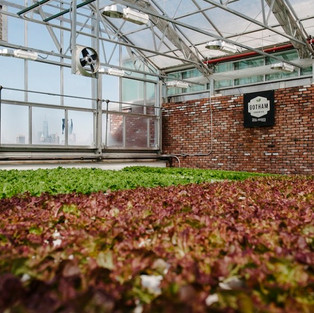As sustainability enthusiasts and professionals, we are constantly bombarded with dire statistics and news. Good stories and news are sometimes far apart and well spaced. Therefore it is with a lot of excitement and happiness I share these two excellent pieces on the future of agriculture, our food systems in general and urban agriculture in particular.
The two exemplary farms are Gotham Greens; a hydroponic venture and the other is AeroFarms. The best part about both these farms are they are viable for-profit businesses!
I know a lot more about Gotham Greens as I was lucky enough to visit their Gowanus facility which resides on the top of Whole Foods Market, a US based organic food grocery chain. Also, a few years ago, as part of my Masters of Science Program, we had the founder Viraj Puri come to my University campus and give an introduction to his company.
Here’s what I learnt about Gotham Greens when I visited them in early May 2015:
The farm is based on the concept of rooftop hydroponics; basically using water (hydro) instead of soil as the growing medium. The first one was started in Green point, Brooklyn and is 15,000 square foot. Since then they have built three others, each larger than its predecessor. The last and largest (possibly in the world) roof top farm is slated to open in Chicago and will cover 75,000 square foot of space.
There is a huge demand for fresh produce in NYC. The Gowanus location produces the same amount of produce as a 10 acre farm; in just ½ acre of space and with 1/10 the water use. This is because water can be recycled and used many more times than once. The produce yield is therefore 20 times that of a conventional farm. That’s just amazing! And because they are indoor, they can produce food 365 days a year.
The other great sustainable feature of hydroponics (besides space and water conservation) is the green supply chain. Since Wholefoods™ is their primary consumer and buyer, the produce is harvested in the morning from the rooftop and sent down same morning to the store. Doesn’t get shorter or fresher than that! This is good for two reasons; one is because of the fact that leafy greens travel the greatest distance in terms of farm to fork for us northeasterners.
Secondly because of the long distances by the time they arrive at our table, they have lost substantial amount of nutrition. For example, leafy greens that come from CA take approximately 10 days to travel to the east coast; Gotham green leafy greens on the other hand are harvested in the morning and available for consumption by noon with an additional 14 days of freshness guaranteed.
It was heartening to learn that they don’t depend on pesticides; instead they have good bugs destroying the bad crop-eating bugs. Each of their greenhouses is a work of art as well as technology; they are all equipped with sensors to control the various inputs required in plant production such as: CO2, O2, water, humidity, and sunlight. When it’s sunny outside, there will be retractable sun shade, whereas in winter when it’s gloomy outside, LED lights turn on to provide necessary and optimal plant growing conditions. Similarly windows open and close based on the difference between inside outside humidity.
This article from Edible Manhattan shares an interview with the co-founder is worth reading. According to the author, his type of farming is not supposed to replace conventional agriculture but to help supplement it. We will have to wait and see how the future is shaped by compounding urbanism but at least there is hope and fresh green lettuce nearby
Regarding AeroFarms: As quoted in this interview with CEO David Rosenberg,“AeroFarms is planning a farm for the future, it is an aeroponic farm — a type of soil-free vertical farming. Aeroponic farmers spray a nutrient-rich mist on the plants’ roots to make them grow. The process requires no sun and no pesticides, and their plants need less space and water than in traditional farming.”
#aeroponics, #David Rosenberg, #food sustainability, #gotham greens, #hydroponics, #sustainable food systems, #urban agriculture, #Viraj Puri





Also reblogged on:
http://www.worldorganicnews.com/19251/where-does-your-lettuce-come-from-search-for-a-greener-life/
Save Green Team says:June 3, 2015 at 12:46 pm
Reblogged this on Save Green Going Green.